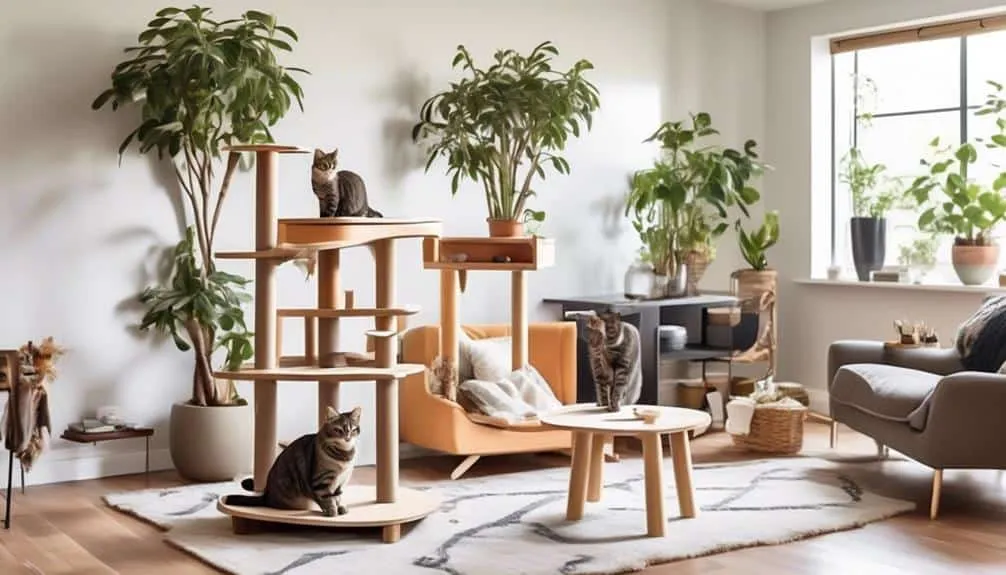The Best Fluffy Pancakes recipe you will fall in love with. Full of tips and tricks to help you make the best pancakes.

Like a towering fortress, a cat tree serves as a symbol of security and territory for your feline companion.
But have you ever wondered where exactly to position this essential piece of furniture to maximize its benefits?
In this discussion, we will explore the art of optimal placement, uncovering the secrets to boosting social significance and preventing pet conflicts.
By unraveling the intricacies of your cat's behavior and understanding their need for a sense of ownership, you will gain valuable insights into creating a harmonious environment for your furry friend.
So, prepare to embark on a journey of discovery as we unravel the mysteries of cat tree placement and unveil the keys to a happy and fulfilled feline life.
Key Takeaways
- Placing the cat tree in a socially significant area, like the living room, allows cats to feel like a part of the family and mingle with their owners.
- Observing your cat's preferred locations can help determine the best room for the cat tree, even if it can't be placed in the exact spot.
- Cat trees can be used to redirect unwanted behaviors, such as scratching, and provide mental stimulation and enrichment for cats.
- Careful placement of the cat tree can help avoid conflicts with other pets by considering the dynamics between them and providing alternative locations for resources.
Importance of Social Significance
Placing the cat tree in a socially significant area, such as the living room, allows cats to feel like valued members of the family and enhances their overall well-being. Cats are social creatures that thrive on companionship and interaction. By providing them with a cat tree in a room where humans spend the most time, you're creating a cat-friendly living room environment that promotes socialization.
This promotes a sense of belonging for your feline companion and helps them feel included in family activities. Additionally, having the cat tree in a socially significant area allows cats to claim prime real estate and mark their territory through scratching. This not only satisfies their natural territorial instincts but also protects your furniture by redirecting their scratching behavior to the cat tree.
Observing Your Cat's Preferred Locations
To better understand the optimal placement of your cat tree, it's important to observe your cat's preferred locations within your home.
Cats have favorite spots where they feel comfortable and secure. By evaluating your cat's comfort, you can determine the ideal placement for the cat tree.
Take note of where your cat likes to hang out, whether it's by a sunny window or in a cozy corner. While it may not always be possible to place the cat tree in the exact spot, it can be placed in the same room.
Cats appreciate having their own space in areas they already enjoy. Considering your cat's habits and preferences can guide you in finding the best location for the cat tree, ensuring their comfort and satisfaction.
Using Cat Trees to Address Behaviors
Cat trees can be a valuable tool for addressing unwanted behaviors in cats. By redirecting unwanted behaviors and providing mental stimulation, cat trees can help improve the overall behavior of your feline companion.
Here are five ways cat trees can be used to address behaviors:
- Redirect scratching behavior to the cat tree, protecting furniture and providing a better alternative.
- Use the cat tree to satisfy your cat's need for elevated perches, reducing the likelihood of them climbing on countertops or other high surfaces.
- Provide mental stimulation and enrichment through the use of various levels, platforms, and interactive toys on the cat tree, reducing boredom and destructive behaviors.
- Place the cat tree near areas where unwanted behaviors occur, such as near curtains or furniture that your cat tends to scratch, to encourage them to use the cat tree instead.
- Utilize the height and vertical space of the cat tree to encourage climbing and jumping, which can help burn off excess energy and reduce hyperactivity or aggression.
Avoiding Conflict With Other Pets
When considering the placement of your cat tree, it's important to take into account the dynamics between your pets in order to avoid potential conflicts.
Cats have complex territorial rules, and careful placement of the cat tree can help minimize territorial conflicts. To avoid creating conflict, it's advisable to provide alternative locations for other pets.
By offering alternative pet locations, such as separate resting areas or elevated perches, you can distribute resources and reduce potential conflicts. Additionally, considering the dynamics between pets is crucial.
It's important to place the cat tree in a neutral area where none of the pets feel their territory is being invaded. By taking these measures, you can ensure a harmonious environment for all your pets.
Stability of the Location and Best/Worst Locations
Placing the cat tree in a stable location is essential to ensure the safety and comfort of your cat. To achieve this, consider the following factors:
- Corner stability: Positioning the cat tree firmly in a corner can help stabilize it, providing a secure and sturdy structure for your cat to climb and play on.
- Wall stabilizers: Some cat trees come with stabilizers that can be mounted into the wall, further enhancing the stability and preventing any wobbling or tipping.
- Main rooms with windows and corners: Optimal locations for cat trees are main rooms where people spend the most time, such as living rooms, dining rooms, and bedrooms. These areas usually have windows and corners, offering extra stability for the cat tree.
- Avoid laundry rooms and garages: These areas aren't ideal due to the lack of windows, potential noise, and discomfort for cats.
- Consider your cat's preferences: Choose a location that meets the needs and preferences of your cat, ensuring they feel safe and comfortable.
Conclusion
In conclusion, strategically placing a cat tree can greatly enhance your furry friend's well-being. By understanding the importance of social significance and observing your cat's preferred locations, you can create a harmonious space that meets their needs.
Cat trees provide a valuable outlet for behaviors and help prevent conflicts with other pets. It's crucial to choose a stable location and avoid placing the tree in the worst spots of your home.
So, embrace the power of the cat tree and watch your feline companion thrive in their own little kingdom!










